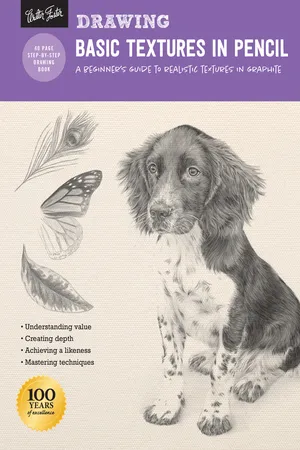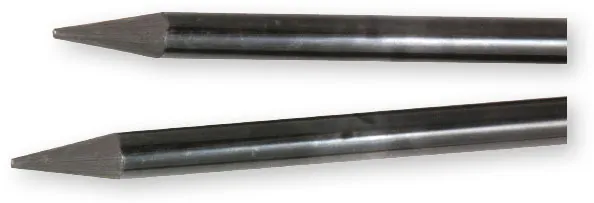
eBook - ePub
Drawing: Basic Textures in Pencil
A beginner's guide to realistic textures in graphite
- 40 pages
- English
- ePUB (mobile friendly)
- Available on iOS & Android
eBook - ePub
Drawing: Basic Textures in Pencil
A beginner's guide to realistic textures in graphite
About this book
Gain the drawing skills you need to create textured works like a pro with Drawing: Basic Textures in Pencil.
From handling the pencil and mastering basic techniques to learning about value, form, and shading, Basic Textures in Pencil teaches beginning artists all of the elements they need to achieve realistic results in their drawings.
Intuitive step-by-step lessons then demonstrate how you can put your newfound skills to use by rendering everything from metal, glass, and wood textures to fur and feathers. Each concept is clearly explained in easy-to-comprehend language, making this book an accessible and approachable resource for beginning artists and art enthusiasts.
Designed for beginners, the How to Draw & Paint series offers an easy-to-follow guide that introduces artists to basic tools and materials and includes simple step-by-step lessons for a variety of projects suitable for the aspiring artist. Basic Textures in Pencil allows artists to widen the scope of their abilities, demonstrating basic pencil drawing techniques that allow beginners to re-create a variety of common textures and surfaces.
From handling the pencil and mastering basic techniques to learning about value, form, and shading, Basic Textures in Pencil teaches beginning artists all of the elements they need to achieve realistic results in their drawings.
Intuitive step-by-step lessons then demonstrate how you can put your newfound skills to use by rendering everything from metal, glass, and wood textures to fur and feathers. Each concept is clearly explained in easy-to-comprehend language, making this book an accessible and approachable resource for beginning artists and art enthusiasts.
Designed for beginners, the How to Draw & Paint series offers an easy-to-follow guide that introduces artists to basic tools and materials and includes simple step-by-step lessons for a variety of projects suitable for the aspiring artist. Basic Textures in Pencil allows artists to widen the scope of their abilities, demonstrating basic pencil drawing techniques that allow beginners to re-create a variety of common textures and surfaces.
Frequently asked questions
Yes, you can cancel anytime from the Subscription tab in your account settings on the Perlego website. Your subscription will stay active until the end of your current billing period. Learn how to cancel your subscription.
At the moment all of our mobile-responsive ePub books are available to download via the app. Most of our PDFs are also available to download and we're working on making the final remaining ones downloadable now. Learn more here.
Perlego offers two plans: Essential and Complete
- Essential is ideal for learners and professionals who enjoy exploring a wide range of subjects. Access the Essential Library with 800,000+ trusted titles and best-sellers across business, personal growth, and the humanities. Includes unlimited reading time and Standard Read Aloud voice.
- Complete: Perfect for advanced learners and researchers needing full, unrestricted access. Unlock 1.4M+ books across hundreds of subjects, including academic and specialized titles. The Complete Plan also includes advanced features like Premium Read Aloud and Research Assistant.
We are an online textbook subscription service, where you can get access to an entire online library for less than the price of a single book per month. With over 1 million books across 1000+ topics, we’ve got you covered! Learn more here.
Look out for the read-aloud symbol on your next book to see if you can listen to it. The read-aloud tool reads text aloud for you, highlighting the text as it is being read. You can pause it, speed it up and slow it down. Learn more here.
Yes! You can use the Perlego app on both iOS or Android devices to read anytime, anywhere — even offline. Perfect for commutes or when you’re on the go.
Please note we cannot support devices running on iOS 13 and Android 7 or earlier. Learn more about using the app.
Please note we cannot support devices running on iOS 13 and Android 7 or earlier. Learn more about using the app.
Yes, you can access Drawing: Basic Textures in Pencil by Diane Cardaci,William F. Powell,Nolon Stacey in PDF and/or ePUB format, as well as other popular books in Arte & Tecniche artistiche. We have over one million books available in our catalogue for you to explore.
Information
TOOLS & MATERIALS
Graphite pencil artwork requires few supplies, and fortunately they are fairly inexpensive. Choose professional pencils and paper, rather than student-grade materials; they will last longer and ensure a higher-quality presentation.
Pencils
Pencils are labeled based on their lead texture. Hard leads (H) are light in value and great for fine, detailed work, but they are more difficult to erase. Soft leads (B) are darker and wonderful for blending and shading, but they smudge easily. Medium leads, such as HB and F, are somewhere in the middle. Select a range of pencils between HB and 6B for variety. You can purchase wood-encased pencils or mechanical pencils with lead refills.
Wooden Pencil The most common type of pencil is wood-encased graphite. These thin rods—most often round or hexagonal when cut crosswise—are inexpensive, easy to control and sharpen, and readily available to artists.

Flat Carpenter’s Pencil Some artists prefer using a flat carpenter’s pencil, which has a rectangular body and lead. The thick lead allows you to easily customize its shape to create both thick and thin lines.

Carpenter’s Pencil
Mechanical Pencil Mechanical pencils are plastic or metal barrels that hold individual leads. Some artists prefer the consistent feel of mechanical pencils to that of wooden pencils; the weight and length do not change over time, unlike wooden pencils that wear down with use.

Mechanical Pencil
Woodless Graphite Pencil These tools are shaped liked wooden pencils but are made up entirely of graphite lead. The large cone of graphite allows artists to use either the broad side for shading large areas or the tip for finer strokes and details.

Woodless Pencil
Graphite Stick Available in a full range of hardnesses, these long, rectangular bars of graphite are great tools for sketching (using the end) and blocking in large areas of tone (using the broad side).

Graphite Stick
Paper
Paper has a tooth, or texture, that holds graphite. Papers with more tooth have a rougher texture and hold more graphite, which allows you to create darker values. Smoother paper has less tooth and holds less graphite, but it allows you to create much finer detail. Plan ahead when beginning a new piece, and select paper that lends itself to the textures in your drawing subject.

Blending Tools
There are several tools you can use to blend graphite for a smooth look. The most popular blenders are blending stumps, tortillons, and chamois cloths. Never use your finger to blend—it can leave oils on your paper...
Table of contents
- Cover
- Title Page
- Contents
- Tools & Materials